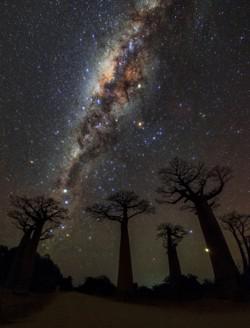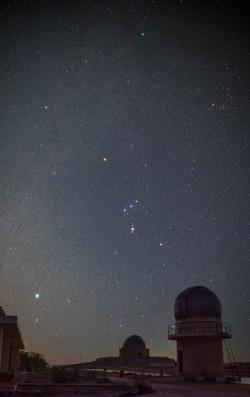Glossary term: Couleur
Description: La couleur d'un objet astronomique peut fournir des informations importantes sur ses propriétés physiques. Même à l'œil nu, une étoile bleuâtre que vous voyez dans le ciel, comme Alkaid à l'extrémité de la "poignée" de la Grande Ourse, est considérablement plus chaude qu'une étoile rougeâtre, comme Bételgeuse dans l'épaule d'Orion. Pour quantifier la couleur, les astronomes déterminent généralement l'éclat d'une étoile lorsqu'elle est observée à travers l'un des quelques filtres bleus spécialisés possibles et la comparent à la luminosité à travers un filtre rouge. Plusieurs définitions distinctes de la couleur de ce type, comparant l'éclat à travers différents filtres spécifiques, sont utilisées. Les résultats peuvent être utilisés dans des analyses statistiques. Les diagrammes couleur-magnitude, qui représentent la couleur d'un objet en fonction de son éclat, en sont un exemple.
Related Terms:
See this term in other languages
Term and definition status: The original definition of this term in English have been approved by a research astronomer and a teacher The translation of this term and its definition is still awaiting approval
The OAE Multilingual Glossary is a project of the IAU Office of Astronomy for Education (OAE) in collaboration with the IAU Office of Astronomy Outreach (OAO). The terms and definitions were chosen, written and reviewed by a collective effort from the OAE, the OAE Centers and Nodes, the OAE National Astronomy Education Coordinators (NAECs) and other volunteers. You can find a full list of credits here. All glossary terms and their definitions are released under a Creative Commons CC BY-4.0 license and should be credited to "IAU OAE".
Related Media
Portrait of a Bat
Credit: Thanakrit Santikunaporn/IAU OAE
License: CC-BY-4.0 Creative Commons Attribution 4.0 International (CC BY 4.0) icons
Voie lactée au-dessus de l'Avenue des Baobabs
Credit: Amirreza Kamkar/UAI OAE
License: CC-BY-4.0 Creative Commons Attribution 4.0 International (CC BY 4.0) icons
Watchtower and Paddy Fields Under the Starry Sky
Credit: Likai Lin/IAU OAE
License: CC-BY-4.0 Creative Commons Attribution 4.0 International (CC BY 4.0) icons
La voie lactée au-dessus de Anglers Reach
Credit: Lucy Yunxi Hu/IAU OAU
License: CC-BY-4.0 Creative Commons Attribution 4.0 International (CC BY 4.0) icons
Winter Constellations
Credit: Mohamed Aboushelib/IAU OAE
License: CC-BY-4.0 Creative Commons Attribution 4.0 International (CC BY 4.0) icons
Related Activities
Reading the Rainbow
astroEDU educational activity (links to astroEDU website) Description: By understanding how rainbows work, you can discover about light and its properties, learning about stars, nebulae, galaxies, and our Universe.License: CC-BY-4.0 Creative Commons Attribution 4.0 International (CC BY 4.0) icons
Age Ranges: 14-16 , 16-19 , 19+ Education Level: Informal , Middle School , Secondary , University Areas of Learning: Interactive Lecture , Observation based , Social Research Costs: Low Cost Duration: 1 hour 30 mins Group Size: Group Skills: Analysing and interpreting data , Asking questions , Engaging in argument from evidence













